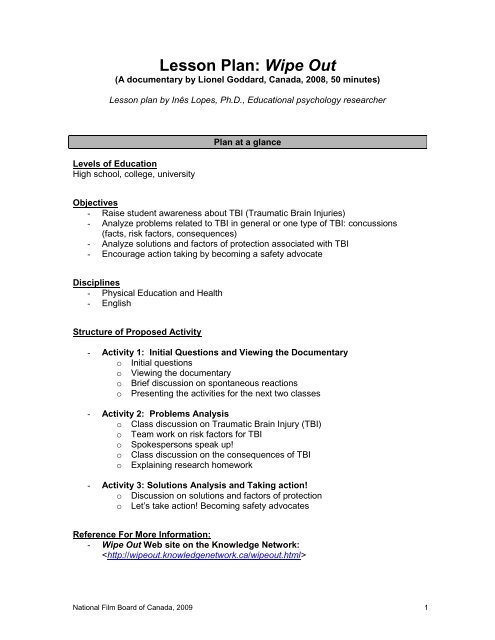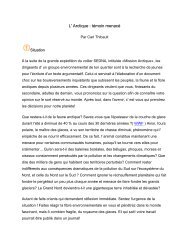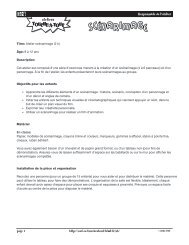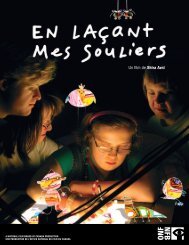Lesson Plan: Wipe Out - Office national du film du Canada
Lesson Plan: Wipe Out - Office national du film du Canada
Lesson Plan: Wipe Out - Office national du film du Canada
You also want an ePaper? Increase the reach of your titles
YUMPU automatically turns print PDFs into web optimized ePapers that Google loves.
<strong>Lesson</strong> <strong>Plan</strong>: <strong>Wipe</strong> <strong>Out</strong><br />
(A documentary by Lionel Goddard, <strong>Canada</strong>, 2008, 50 minutes)<br />
<strong>Lesson</strong> plan by Inês Lopes, Ph.D., E<strong>du</strong>cational psychology researcher<br />
Levels of E<strong>du</strong>cation<br />
High school, college, university<br />
<strong>Plan</strong> at a glance<br />
Objectives<br />
- Raise student awareness about TBI (Traumatic Brain Injuries)<br />
- Analyze problems related to TBI in general or one type of TBI: concussions<br />
(facts, risk factors, consequences)<br />
- Analyze solutions and factors of protection associated with TBI<br />
- Encourage action taking by becoming a safety advocate<br />
Disciplines<br />
- Physical E<strong>du</strong>cation and Health<br />
- English<br />
Structure of Proposed Activity<br />
- Activity 1: Initial Questions and Viewing the Documentary<br />
o Initial questions<br />
o Viewing the documentary<br />
o Brief discussion on spontaneous reactions<br />
o Presenting the activities for the next two classes<br />
- Activity 2: Problems Analysis<br />
o Class discussion on Traumatic Brain Injury (TBI)<br />
o Team work on risk factors for TBI<br />
o Spokespersons speak up!<br />
o Class discussion on the consequences of TBI<br />
o Explaining research homework<br />
- Activity 3: Solutions Analysis and Taking action!<br />
o Discussion on solutions and factors of protection<br />
o Let’s take action! Becoming safety advocates<br />
Reference For More Information:<br />
- <strong>Wipe</strong> <strong>Out</strong> Web site on the Knowledge Network:<br />
<br />
National Film Board of <strong>Canada</strong>, 2009 1
Activity 1: Initial questions and Viewing the Documentary (75 min)<br />
1. Initial questions for the whole class:<br />
- Which sports do you practise<br />
- What kinds of injuries could happen to you while practising that<br />
sport<br />
- In your opinion, which sports could lead to most severe injuries<br />
- Do you think some people have personalities that are more prone<br />
to risk taking<br />
- Do you know anybody who has suffered brain injury<br />
- What do you think are the consequences of brain injury<br />
- Do you think boys and girls engage in as much risky behaviour in<br />
sports<br />
<br />
15 min<br />
2. View the documentary 50 min<br />
3. Brief discussion on spontaneous reactions<br />
For the few minutes left, ask students to share their spontaneous<br />
thoughts on the documentary.<br />
4. Present the two next classes’ activities<br />
8 min<br />
2 min<br />
- Activity 2 will be devoted to further discussing the problems related<br />
to Traumatic Brain Injuries<br />
- Activity 3 will focus on thinking about solutions and taking action!<br />
National Film Board of <strong>Canada</strong>, 2009 2
Activity 2: Problems Analysis (75 min)<br />
1. Class discussion on Traumatic Brain Injury (TBI). Start a class discussion by<br />
asking these questions:<br />
- What happened to the three young men we saw in the documentary<br />
- Before watching the <strong>film</strong>, were you aware that TBI was the number one<br />
cause of death and disability among youth<br />
- Is TBI (Traumatic Brain Injury) the same as a concussion* What is the<br />
difference between the two<br />
* For more information on TBI or concussions, refer to the Appendix or the Web site:<br />
- Learn section<br />
2. Teamwork on risk factors for TBI.<br />
Divide the class into teams of 5. Ask students to list, as teams, why there are so<br />
many cases of TBI in their opinion. They write their ideas on paper and<br />
determine who will be spokesperson for the team. Give them 15 minutes to<br />
discuss and list their ideas.<br />
3. Spokespersons speak up!<br />
Ask each team’s spokesperson to stand up so that you can compile their ideas.<br />
Draw four columns on the board with these categories on top: neurobiological,<br />
sociodemographic, social and media. As the spokespersons share their<br />
teams’ conclusions on the risk factors, write them under the appropriate column.<br />
Refer to the Appendix for an example. Other answers might come up; if they<br />
don’t fit into any of those categories, add a fifth column for “Other” (e.g. recent<br />
years’ increase in popularity for sports such as snowboarding). Also, make sure<br />
you specify that often, it is not a single factor but a combination of those that<br />
explain why TBI occurs.<br />
4. Class discussion on the consequences of TBI<br />
<br />
15 min<br />
15 min<br />
20 min<br />
15 min<br />
- What are the consequences of brain injuries on the person suffering them<br />
(Explore topics such as memory loss, concentration difficulties, motor<br />
impairment, personality changes [i.e. “not being the same person”], etc.)<br />
- What are the consequences on their entourage (Explore topics such as:<br />
emotional stress for family and friends; taking care of an injured person<br />
requires time and dedication, which often bring life changes [e.g. having to<br />
quit one’s job; moving to be closer to services, such as in Chris Tutin’s case],<br />
etc.).<br />
5. Explain research homework. Divide class into four groups. Assign homework<br />
to each group (homework is to be done indivi<strong>du</strong>ally; groups are only formed to<br />
assign 4 homework categories). Explain that their research will help them for the<br />
next activity: becoming safety advocates.<br />
Here are the four research* tasks (one per group):<br />
a. Brain injuries: Research one of these topics: TBI, Concussions, or<br />
Brain Anatomy (brain’s functions by section: frontal lobes, parietal lobes,<br />
occipital lobes, temporal lobes and cerebellum).<br />
b. Risk factors<br />
c. Helmets<br />
d. Taking the online quiz and noting important facts<br />
* Information for these four research tasks can be found on the <strong>Wipe</strong> <strong>Out</strong> Web site:<br />
- Learn section<br />
10 min<br />
National Film Board of <strong>Canada</strong>, 2009 3
Activity 3: Solutions Analysis and Taking Action! (75 min)<br />
1. Discussion on solutions and factors of protection.<br />
The last activity focused on problems associated with TBI. This one will<br />
take a more positive angle and explore solutions and factors of<br />
protection. Ask students what are some solutions, in their opinion, to help<br />
prevent TBI or simply to help deal with it. If they don’t name them, make<br />
sure that you talk about:<br />
<br />
20 min<br />
Solutions for the prevention of TBI<br />
- Helmets (TBI is the number one cause of death and disability<br />
among youth. It is also one of the most preventable ones. 60 to<br />
85% of injuries can be prevented by using a helmet).<br />
- Public e<strong>du</strong>cation campaigns<br />
Post-TBI Solutions<br />
- Treatment and therapy (various types: medical care,<br />
physiotherapy, occupational therapy, psychology, etc.)<br />
- Having a support network (e.g. family and friends that are there for<br />
you)<br />
- Developing personal strategies to cope (e.g. finding alternative<br />
activities one enjoys, etc.)<br />
2. Let’s take action! Becoming safety advocates<br />
Form teams of four. Make sure that each team has a member of each of<br />
the homework groups (a, b, c and d) in order to have an “expert” on each<br />
topic in every team.<br />
55 min<br />
- Tell students they will become safety advocates themselves<br />
today. They will be making posters to be displayed, if possible, on<br />
the gym’s walls or elsewhere in the school where safety<br />
messages can be seen. They can use facts, slogans, images or<br />
other means they can think of to spread awareness and safety<br />
messages.<br />
- An extension of this could be going from class to class, to those<br />
who haven’t seen the documentary, to tell them about TBI facts<br />
and ways to prevent them.<br />
National Film Board of <strong>Canada</strong>, 2009 4
Appendix: Basic information from the <strong>Wipe</strong> <strong>Out</strong> Web site<br />
<br />
A Healthy Brain<br />
Inside the brain, neurons form tracts that carry messages to various parts of the brain. The brain<br />
uses these messages to perform functions that coordinate the body’s life systems and comprise<br />
every movement, thought, sensation and emotion of the human experience. Each part of the<br />
brain serves a specific function and links with other parts of the brain to perform more complex<br />
functions.<br />
An Injured Brain (Traumatic Brain Injury)<br />
Traumatic Brain Injury (TBI) occurs when an outside force impacts the head hard enough to<br />
cause the brain to move inside the skull. It can then cause bruising, bleeding, twisting or tearing<br />
of brain tissue. The injury can affect the functions of the neurons, nerve tracts or different sections<br />
of the brain. This can change how a person thinks, acts, feels and moves. It can also affect the<br />
complex internal functions of the body. Brain injuries are all different. Some are temporary, others<br />
permanent. Some cause partial impairment, others a complete inability to perform a function.<br />
Concussions<br />
Concussions are the most common kind of Traumatic Brain Injury (TBI). Concussions are caused<br />
by a direct or indirect blow to the head or body that pro<strong>du</strong>ces a temporary loss of normal brain<br />
function. Suffering a single, even mild, concussion greatly increases the risk of more severe<br />
injuries – or even death. Repeated concussions can cause profound and prolonged impairments<br />
on brain function and behaviour, including long-term memory loss, re<strong>du</strong>ced processing speed and<br />
depression.<br />
Symptoms and signs: Symptoms vary widely and often disappear within minutes or<br />
appear later, making the injury’s severity and recovery requirements difficult to determine.<br />
Symptoms can include: confusion, disorientation, headache, nausea, dizziness, blurred<br />
vision, slurred speech, fatigue and irritability. Signs can include: inappropriate behaviour,<br />
vacant stare, poor balance, mood swings and problems with concentration, memory and<br />
sleeping.<br />
What to do: If you suffer ANY head injury, STOP playing. If you suffer any signs and/or<br />
symptoms of a concussion, you shouldn’t be alone and you must seek medical advice as<br />
soon as possible. If you’ve suffered loss of consciousness, get immediate medical<br />
attention.<br />
National Film Board of <strong>Canada</strong>, 2009 5
Risk factors<br />
Neurobiological<br />
factors<br />
Sociodemographic<br />
factors<br />
Social factors<br />
Media factors<br />
- The teenage brain<br />
Double risk:<br />
1) Prefrontal<br />
cortex, which<br />
evaluates risk and<br />
inhibits risky<br />
behaviour, not yet<br />
fully developed;<br />
2) Reward system<br />
overactive in<br />
adolescence<br />
- Thrill-seeking (or<br />
‘T type’)<br />
personalities<br />
- Previous brain<br />
injuries (After one<br />
BI you have a 3<br />
times greater risk<br />
for a 2 nd BI)<br />
- Sex (males are<br />
twice as much at<br />
risk as females)<br />
- Age (males 15-24<br />
are particularly at<br />
risk)<br />
- Crowds you hang<br />
out with (“Birds of a<br />
feather flock<br />
together”; Thrillseeking<br />
types tend<br />
to hang out with<br />
friends like<br />
themselves)<br />
- Peer pressure<br />
- Video-sharing sites<br />
on the Internet<br />
(When a camera is<br />
present, some teens,<br />
especially the thrillseeking<br />
type, may<br />
exaggerate)<br />
- Television<br />
- Video games (e.g.<br />
Skaters never wear<br />
helmets in video<br />
games)<br />
National Film Board of <strong>Canada</strong>, 2009 6





